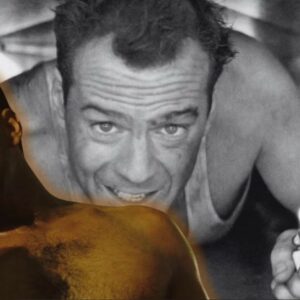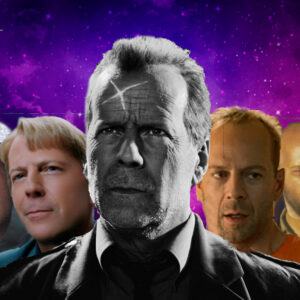Introduction to Bruce Willis’ Iconic Action Career
Bruce Willis is a name synonymous with action cinema. From the explosion of adrenaline-fueled blockbusters to the iconic one-liners, Willis has built a reputation that goes beyond mere stardom. He is, arguably, one of the most influential figures in the world of action films. As the indomitable John McClane in Die Hard and the wisecracking Korben Dallas in The Fifth Element, Willis has redefined the genre, blending intense physicality with effortless cool. Over the course of a career that spans decades, Willis has starred in numerous action thrillers, each marked by explosive sequences and perilous stunts that have earned him a reputation as a true action hero.
What makes Bruce Willis’ action films stand out, however, is not just the thrills and pyrotechnics, but the authenticity and realism he brings to each role. While many action stars rely on stunt doubles or visual effects, Willis’ commitment to performing his own stunts has set him apart. Through his willingness to push physical limits and take risks, Willis has redefined what it means to be an action hero in Hollywood.
This article will explore the iconic career of Bruce Willis, with a focus on his contributions to the genre through dangerous action sequences, his personal commitment to performing stunts, and his influence on the action movie landscape.
Overview of Bruce Willis as an Action Movie Star
Bruce Willis’ journey into action stardom began in the late 1980s, when he was cast as New York cop John McClane in Die Hard (1988), a role that would change his life and the world of action cinema. Unlike the muscular, larger-than-life heroes who had dominated action movies up until then, McClane was everyman — a wisecracking, blue-collar cop who finds himself in extraordinary circumstances. Die Hard turned out to be a game-changer, transforming Willis from a TV actor best known for Moonlighting into a bona fide action superstar.
What made Die Hard so revolutionary wasn’t just the plot or the unforgettable villain, Hans Gruber (played by Alan Rickman), but the fact that McClane was a regular guy trying to survive against impossible odds. He didn’t possess superhuman strength or a perfect body; instead, he used his wits, resourcefulness, and, perhaps most importantly, his unyielding determination to defeat the terrorists. This relatability resonated with audiences, and Willis’ everyman persona made him the perfect fit for the role of the reluctant hero.
The success of Die Hard established Willis as a versatile action star who could deliver both the drama and the thrills. His career took off with a string of successful action films that capitalized on his ability to balance humor with toughness. The Last Boy Scout (1991) saw him as a disgraced private investigator navigating a world of corruption and violence, while The Fifth Element (1997) introduced him to a more fantastical, high-tech action genre, where he played a taxi driver turned reluctant hero in a futuristic battle to save the universe.
Willis’ signature blend of tough-guy attitude and snarky humor became a staple of his action roles. It’s this mix of humanity and resilience that set him apart from other action stars. Instead of relying on superhuman feats, Willis brought his characters to life with grit and determination, making them feel more grounded and relatable. Whether fighting terrorists, saving the world, or outwitting ruthless criminals, Willis brought an authenticity to each performance that made him stand out in the genre.
Notable High-Risk Action Scenes
Willis’ films are known for their exhilarating action sequences, many of which pushed the limits of what was possible in Hollywood at the time. While modern CGI and visual effects allow filmmakers to create dangerous stunts in a digital environment, Willis’ films often relied on real, practical effects, making the danger feel more immediate and visceral. There are numerous iconic moments from his career that demonstrate his commitment to performing his own stunts, even when the risk was high.
One of the most famous high-risk scenes in Willis’ career occurs in Die Hard during the iconic skyscraper jump. As McClane, Willis leaps from one building to another, narrowly escaping a dangerous situation. The stunt is heart-pounding and looks as dangerous as it feels. While some of the physicality may have been enhanced with camera angles and special effects, Willis famously did much of the stunt himself, creating a sense of realism that keeps audiences on the edge of their seats. The scene became a defining moment in the Die Hard franchise and a symbol of the danger and tension that marked the film.
Another standout sequence is found in Armageddon (1998), where Willis stars as Harry Stamper, a blue-collar oil driller tasked with stopping an asteroid from colliding with Earth. The film’s most memorable and high-stakes action scene takes place in space, where Willis’ character and his crew must perform a series of perilous maneuvers to destroy the asteroid. The scene blends high-risk physical action with sci-fi spectacle, and while much of the sequence relied on special effects, the sense of urgency and danger was real. Willis, again, performed many of the stunts himself, committing to the scenes with a physicality that kept the stakes high and the tension palpable.
In The Last Boy Scout (1991), Willis’ character, Joe Hallenbeck, is involved in an intense car chase that becomes one of the film’s defining action sequences. The scene features Willis’ character being chased through the streets while attempting to outmaneuver a gang of merciless pursuers. It’s a blistering sequence full of sharp turns, crashes, and close calls, and again, Willis’ commitment to performing many of his own stunts heightens the realism. The relentless speed and chaotic nature of the chase, coupled with Willis’ natural athleticism, make it one of the most thrilling moments in the film.
Behind the Scenes: Stunt Coordination
Stunt coordination is an essential aspect of making action films, especially when dealing with high-risk sequences like the ones Willis is known for. While Willis’ commitment to performing his own stunts is admirable, it’s important to recognize the role that professional stunt coordinators play in ensuring the safety of everyone involved in the production.
In each of Willis’ films, a team of highly trained stunt coordinators and safety experts work meticulously to plan out every dangerous sequence. These professionals are responsible for designing the stunts in a way that minimizes risk while still delivering the excitement and thrills that audiences expect from an action movie. The process typically begins with the development of the stunt itself, followed by rehearsals and safety checks before the actual filming begins.
For a high-stakes sequence like the skyscraper jump in Die Hard, coordinators would have worked with Willis to ensure that the jump was performed safely. This includes preparing for possible injuries, ensuring that appropriate safety measures were in place (such as harnesses and crash mats), and working out the timing of the stunt in such a way that it would look as dangerous as it felt, without putting anyone in unnecessary harm.
One of the key aspects of professional stunt coordination is communication. Stunt coordinators must work closely with the director, the actors, and the rest of the crew to ensure that everyone is on the same page about the logistics of each sequence. Given the nature of action films, where time is often a luxury, having a well-coordinated team ensures that these complex stunts can be performed with precision while maintaining safety standards.
Bruce Willis’ Personal Commitment to Stunts
Bruce Willis is known for his hands-on approach to stunts. His willingness to get involved in dangerous action sequences and perform his own stunts is one of the key factors that has made him a beloved figure in the action genre. Willis has always believed in the importance of authenticity in his films, and performing stunts himself allows him to bring a level of realism to his characters that few other actors can match.
Willis has often discussed the physical toll that action films have taken on his body. The intense stunts and action scenes have left him with numerous injuries over the years, but his commitment to realism and his drive to deliver the best performance possible have kept him coming back for more. The physical strain of doing his own stunts can be grueling, but Willis has always prioritized the realism that comes with performing dangerous actions.
His dedication to his craft is evident not only in the stunts he performs but also in the way he prepares for them. Willis has been known to spend hours in rehearsals, training to ensure that he is ready to tackle each stunt head-on. His commitment to physicality and authenticity has set a standard for other action stars to follow.
Legacy of Bruce Willis’ Action Sequences
Bruce Willis’ contributions to action cinema have had a lasting impact on the genre. His high-risk action sequences, combined with his ability to bring depth and humanity to his characters, have influenced generations of action stars. Before Willis, many action films relied on larger-than-life heroes who were more superhero than human. Willis, however, redefined the action hero as someone who was relatable, vulnerable, and driven by sheer determination.
The long-term impact of Willis’ films can be seen in the way modern action heroes are portrayed. The authenticity he brought to his performances, particularly in high-risk stunts, has inspired a new generation of actors to push the boundaries of physical performance. The trend of action stars performing their own stunts — as seen with actors like Tom Cruise and Keanu Reeves — can be traced back to Willis’ willingness to take on dangerous sequences and make them look effortless.
Conclusion
Bruce Willis’ contributions to the action genre cannot be overstated. His commitment to performing high-risk stunts, coupled with his talent for bringing authenticity to his roles, has redefined what it means to be an action star. From the skyscraper jump in Die Hard to the asteroid mission in Armageddon, Willis’ action sequences have become iconic moments in cinema history. His legacy is one of dedication, grit, and a willingness to push physical limits in order to create thrilling, unforgettable moments for audiences. In doing so, he has paved the way for future action heroes and set a high standard for what it takes to be a true action icon.





